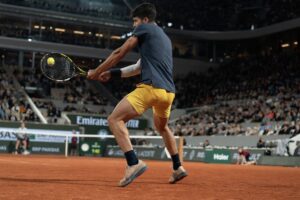As we headed into the offseason following 2019, one could not help but be optimistic that 19-year-old Thiago Seyboth Wild would start out 2020 hot. If Seyboth Wild could keep up the level he was starting to show on a consistent, then he could begin 2020 with a push to reach the top 100 in the world.
But, things didn’t work out that way. In fact, Seyboth Wild had a fairly nightmarish start to the year. However, things are looking up once more following his performance in the ATP 500 event in Rio de Janeiro.
Thiago Seyboth Wild Strong Finish in 2019
One can trace back the origins of the Seyboth Wild’s run at the end of 2019 to a September third round match in the Buenos Aires Challenger against Agustin Velotti. In this clay court match, Seyboth Wild was clearly the better player with the much bigger groundstrokes that should have, theoretically, hit through Velotti.
However, Velotti used variety and Seyboth Wild’s erratic consistency from the baseline to frustrate the Brazilian greatly, ultimately taking the match in three sets. Yet, reflecting on the match, one couldn’t help but feel that Seyboth Wild was close. If he could rein in his groundstrokes just a little, he was going to be a very dangerous player.
Starting on the clay of the the Lima Challenger in October, Seyboth Wild started to transform into the scary player that had been lurking under the surface. In Lima, he made a run to the quarterfinals which included wins over Marco Cecchinato and Andrea Collarini before ultimately falling to Juan Pablo Varillas.
Seyboth Wild then won the Guayaquil Challenger on the clay courts of Guayaquil, Ecuador. Seyboth Wild only lost one set all tournament and had five wins in a row against higher-level Challenger clay courters: Thiago Monteiro, Jozef Kovalik, Francisco Cerundolo, Juan Pablo Varillas, and Hugo Dellien. In fact, in the final against Dellien, Seyboth Wild only dropped four games.
In an interview with Josh Meiseles of AtpChallengerTour.com, Seyboth Wild stated, “…I can’t even describe the sensations right now. It’s just the start of something I’ve been planning for so long. I’m sure if I keep working hard and stay on the right path, I’ll keep winning.”
And Seyboth Wild was able to carry this clay court momentum into the Montevideo Challenger to finish the 2019 season. Taking down Juan Pablo Ficovich, Yannick Hanfmann, Federico Coria, and Dellien, Seyboth Wild advanced to the semifinals without losing a set. However, all the tennis finally caught up to him against Jaume Munar, a consistent grinder. Munar beat Seyboth Wild in three sets.
What made Seyboth Wild’s game really come together over this stretch was his forehand. Utilizing enough topspin to give his forehands enough margin, yet getting enough racquet-head speed to ensure a high velocity, his forehand developed into a massive weapon that many players couldn’t effectively handle.
With the momentum of a tremendous end to 2019 propelling Seyboth Wild forward, it seemed as if the offseason was coming at a poor time for the Brazilian. Yet, one expected with some time off to further work through the deficiencies in his game, such as a backhand that could still use work, that Seyboth Wild would start out 2020 red-hot.
Yet, sometimes expectations don’t line up with reality.
Rough Start to 2020
Seyboth Wild started 2020 with three consecutive losses. His Australian Open qualifying loss to Peter Gojowczyk was understandable as Seyboth Wild’s game had really only blossomed on clay courts, thus far. And the loss in Cordoba qualifying to Varillas could be explained away too, given Varillas’ own run at the end of last season.
Yet, the loss sandwiched in the middle of these other results was disturbing. Taking on World No. 358 Hernan Casanova in the Punta del Este Challenger, Seyboth Wild fell. Casanova won the third set 6-1, a fairly shocking result.
Seyboth Wild went to this week’s ATP 500 clay court event in Rio de Janeiro completely out of form. Yet, his play in Rio gave supporters some reasons for hope.
The first round of Rio featured a matchup between Seyboth Wild and 20 year-old Alejandro Davidovich Fokina. It felt like a referendum on where Seyboth Wild stood compared to someone around his age.
In a match lasting 3 hours and 51 minutes, Seyboth Wild was able to squeak past Davidovich Fokina 5-7, 7-6(3), 7-5. This was only the second ATP Tour-level win of the Brazilian’s career, having beaten Elias Ymer in the first round of Sao Paolo last season. Seyboth Wild had to save three match points at *5-6 (0-40) in the second set.
Given how the season started, it would have been easy for the Brazilian to get down on himself and go away meekly in the same match. It must be said that the home crowd really helped him get over the line, picking him up when he was down. However, the crowd isn’t the one playing and Seyboth Wild still had to perform had a high level and show extraordinary endurance to win this one.
In the next round against Borna Coric, Seyboth Wild was in a similarly tight match, but found himself on the wrong end of this one. Coric beat Seyboth Wild 6-3, 1-6, 7-6(5). Seyboth Wild was unable to convert any of his four break points in the third set and did not face a break point in his last ten service games.
Even in the loss, one has to admire how Seyboth Wild fought back from *4-0 down in the final set tiebreak to get back to *4-4. The Brazilian’s forehand was world-class throughout both matches and he gave the world a peak into the level he had shown during late-season Challengers last season.
Yet, ultimately, it wasn’t enough. And no matter how close the Coric match was, it still counts as a loss and brings Seyboth Wild’s record on the season to 1-4.
What’s Next for Thiago Seyboth Wild?
So, where does Seyboth Wild go from here? Rio felt like a mixed-bag. On the one-hand, it was great for Seyboth Wild to get his second ATP win and he showed that he could compete at this level. On the other-hand, winning one match and coming close in a second doesn’t exactly equate to “making a run” at the tournament.
Seyboth Wild’s status for Santiago next week is currently uncertain. However, one should expect, regardless, that Seyboth Wild go back down to the Challenger level soon. This will be good because, given his form in Rio, he should really thrive in upcoming clay court Challengers. Yet, the recent loss to Casanova is still worrying. Was it the home crowd pushing Seyboth Wild to his level in Rio or can he continue reproduce that level elsewhere, like he did late last season?
It’s important to remember that Seyboth Wild is still only 19 years old. He has plenty of time to develop into the type of player that he has the potential to be. It’s important to not jump to conclusions based on a few matches. It’s only February, after all.
Seyboth Wild has an explosive forehand, a powerful first serve, and good movement. The sky is truly the limit.
The Brazilian told Meiseles later in the interview after his title in Guayaquil, “I think that if I keep working and look towards bigger things, I’ll have better results.”
The better results haven’t come yet in 2020 for Thiago Seyboth Wild. Yet, if his level in Rio are any indication of the direction his play is headed, then 2020 could still be Seyboth Wild’s ATP Tour breakthrough season.
Main Photo:
Embed from Getty Images






